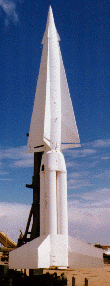Apogee Components Nike-Hercules Plan
Apogee Components - Nike-Hercules {Kit}
Contributed by Michael Rangitsch
| Construction Rating: | starstarstarstarstar_border |
| Flight Rating: | starstarstarstarstar |
| Overall Rating: | starstarstarstarstar_border |
| Manufacturer: | Apogee Components  |

This is a sport scale version of the Nike Hercules anti aircraft missile. Extremely challenging to build. The plans are available from Apogee Components.
Construction:
Booster is a cluster of four (4) 13mm tubes staging through a transition piece to a single 18mm sustainer. Apogee supplies the plans for all the balsa parts and the paper transitions and shrouds. All other supplies are the responsibility of the builder. The construction of the Nike Hercules is extremely challenging. The most difficult parts were maintaining alignment of the extremely long fins on the sustainer and the construction of the paper transition from the booster's square cluster to the sustainer's 18mm tube. This transition piece also holds the sustainer in place with an internal centering ring. I tried to figure out a way to use something stronger than cardstock for this internal ring, but during the initial build I had no luck. After a crash I was able to rebuild it by adding a thin plywood ring to the paper collar before I attached it to the cluster tubes. Kinda tough to describe. Basically take your time in the construction and follow the plans. It works fairly well. I had problems with igniting the sustainer. The booster uses four (4) A10-0T motors with a bit of a gap between them and the sustainer. You have to add a significant amount of nose weight to get the CP/CG relationship recommended in the plans. I used clay and a couple small pieces of lead. The motors are all friction fitted. Finishing: Construction Rating: 4 out of 5 Flight: Flight Rating: 5 out of 5 Summary: Overall Rating: 4 out of 5
Finishing was simply using Elmer's Fill & Finish on the balsa, followed by a coat of white Krylon paint.
The first two flights I used a B4-6 for the sustainer, but couldn't get it to light. The resulting flights were nice, straight nose dives, but with soft ground both times, damage was limited to the staging coupler. The third flight I used an Apogee staging ignitor with a B6-6 in the sustainer. This time it worked perfectly, at least for staging. The boost on this flight was very straight, followed by a hesitation and sustainer ignition, also for a straight flight. Ejection was just after apogee. Now the problem. It seems that only 3 of the booster motors lit initially. At staging, the exhaust from the sustainer lit the fourth motor from the front end, causing a nice fire exiting forward. This destroyed the coupler and a good length of the booster tubes before the booster hit the ground. I have to chalk the booster up as a total loss, even though the sustainer recovered with no damage. Still an impressive flight.
Nice, challenging rocket to build and fly. I had a lot of fun with it. Staging a cluster to a single motor is a challenge, worth the effort.
 |
 |